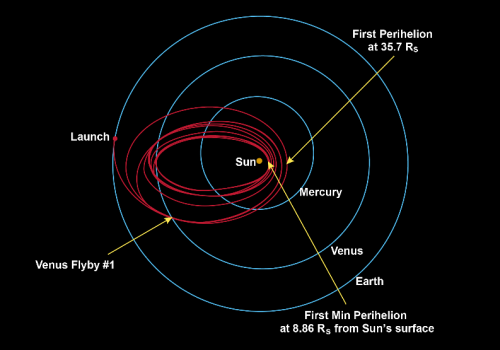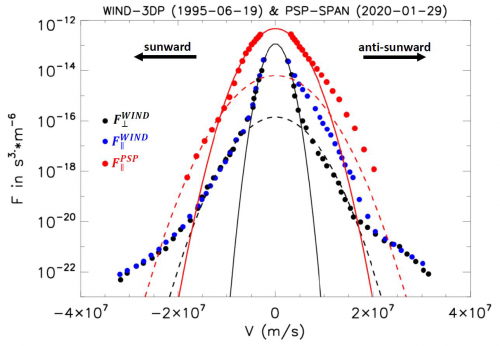The importance of suprathermal electrons
Using an exospheric model based on Kappa distributions, BIRA-IASB’s ‘Solar wind’ team showed that the presence of suprathermal particles, and especially of an enhanced population of electrons (eV to several keV) in the low corona, can explain the coronal heating and the acceleration of the fast solar wind ([1] for a review).
Suprathermal particles are charged ions and electrons that move at speeds two to hundreds of times faster than the thermal plasma of the solar wind. The presence of power law tails for the escaping electrons increases the electric potential and accelerates the wind to values observed in the high-speed solar wind, keeping realistic temperatures in the solar corona. It was thus crucial to determine whether such suprathermal tails, that are observed at large distance in the solar wind, are already present at low distances.
Parker Solar Probe observations
This presence of suprathermal tails close to the Sun is now confirmed thanks to the observations of PSP that could measure the velocity distribution functions of the solar particles at radial distances lower than 15 Rs (solar radii) in 2022. The orbit of PSP is illustrated in Figure 2 and shows perihelion very close to the Sun. In 2024, PSP will even reach distances lower than 10 Rs.
Figure 3 illustrates an example of electron velocity distributions measured by the NASA WIND 3D Plasma Analyser at 1 AU (Astronomical Unit): in blue in the parallel direction and in black in the direction perpendicular to the magnetic field [1]. In red, new observations of PSP at 29 Rs in the parallel direction. Maxwellian fits of the core (solid lines) and the halo (dashed lines) of WIND (in black) and PSP (red) observations are also illustrated, showing the presence of suprathermal tails. We have studied the radial evolution of the suprathermal halo population and its influence on the core [2].
The new PSP observations detected also broadband electrostatic waves in the near-Sun solar wind [3]. With Chinese colleagues, we published several papers on the occurrence of various instabilities expected and observed to change under different solar wind conditions and at different heliocentric distances. Nonlinear evolution of instabilities and plasma turbulence in the solar wind is also investigated in the framework of the Fed-tWIN project ENERGY ().
References
- Pierrard V., M. Lazar, M. Maksimovic (2021), Suprathermal populations and their effects in space plasmas: Kappa vs. Maxwellian, and Maksimovic M., A. Walsh, V. Pierrard, S. Stverak, I. Zouganelis, Electron Kappa distributions in the solar wind: cause of the acceleration or consequence of the expansion?, Chapters in book “Kappa Distributions, From Observational Evidences via Controversial Predictions to a Consistent Theory of Nonequilibrium Plasmas”, Editors: M. Lazar and H. Fichtner (Springer/Nature-Astrophysics and Space Science Library), p. 15-38, eBook ISBN 978-3-030-82623-9, Print ISBN 978-3-030-82622-2.
- Pierrard V., M. Lazar, S. Stverak (2022), Implications of the Kappa Suprathermal Halo of the Solar Wind Electrons, Frontiers in Astronomy and Space Sciences, 9, doi: 10.3389/fspas.2022.892236.
- Zhao J., Malaspina M. D., Dudok De Wit T., Pierrard V., Voitenko, Y., Lapenta G., Poedts, S. Bale S. D., Kasper J. C., Larson D., Livi R., Whittlesey P. (2022), Broadband Electrostatic Waves in the Near-Sun Solar Wind Observed by the Parker Solar Probe, The Astrophysical Journal Letters, 938(2): L21, doi: 10.3847/2041-8213/ac92e3.
- Heliospheric Energy Budget: From Kinetic Scales to Global Solar Wind Dynamics


